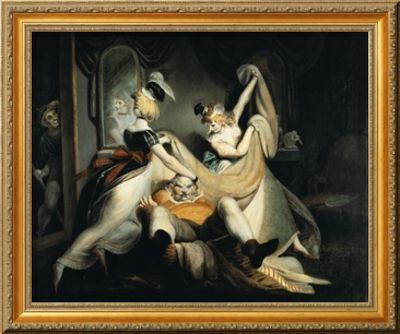by Paul J. Pelkonen

Falstaff in the Laundry Basket by Johann Heinrich Füssli, painted in 1792.
(Ed. note: This is the last installment in The Verdi Project, Superconductor's deep dive into the major operas of Giuseppe Verdi. This project started with Nabucco back in February of this year and has covered fourteen (half) of the composer's twenty-eight operas. In coming weeks, Superconductor will finish The Richard Strauss Project and then figure out what composer is next.)Sometimes the end is the beginning and sometimes the beginning is the end. In order to understand Falstaff, Giuseppe Verdi's final opera and only successful comedy, one must look back to the year 1840 when the composer than a young man had a miserable failure at La Scala with Un Giorno di Regno, his second opera. This was a forgettable comedy of mistaken identities surrounding the royal court of Poland. Today, Un Giorno di Regno is infrequently revived, usually as part of "marathon" performances of all twenty-eight Verdi operas.
After Giorno flopped, Verdi turned away from comedy, making his name with a string of grand and bloody tragedies, although works like Un Ballo in Maschera and La Forza del Destino had comic moments. No, Verdi was the great creator of tragic opera that, at its best, mined the depths of the human condition. However, with Falstaff, his second collaboration with librettist Arrigo Boito and third raid on the works of William Shakespeare, he succeeded in presenting those depths in aew n way that made the world laugh.
The project was a secret, referred to by Verdi and Boito as Il pancione ("The Big Belly".) The secrecy was because Verdi was worried, that late in life, he might not live to finish the opera. The result of their labors was a comic masterpiece, a truncation of Shakespeare's The Merry Wives of Windsor (two pranks are played on Falstaff instead of the three in the play) with interjections of dialog and monologues from the other two "Falstaff" plays, Henry IV Pt. I and II.
As in the play, Sir John Falstaff is a towering comic figure, a morbidly obese knight who is at once wise and foolish, cowardly and brave, and dishonorable in the extreme. Flanked by his lackeys Pistola and Bardolfo, he dwells and drinks in the Garter Inn, but lacks the munificence to keep his paunch in a healthy, oblate shape. Falstaff conceives of a plan, to woo the wealthy wives of two local merchants and lay his sticky fingers on their respective husband's purses. Unfortunately he writes them identical love letters. Reading them, the wives: Meg Page and Alice Ford, plot revenge.
Verdi's musical style underwent a further revolution in the transition from Otello to Falstaff. Melodies in the latter opera are short and terse, but the entire fabric is woven from threads that glitter with melodic invention. There are no formal numbers but there are many ariettas, sounds and sweet airs that delight and beguile the ear. The best of these are sung by Nannetta (Alice's daughter), a high soprano. In a subplot (carried over from Merry Wives, Nannetta wants to marry the handsome young Fenton instead of creepy old Dr. Caius.
Falstaff is a tour de force role for a comic bass. Many of the greatest have strapped on the traditional girth pillow and sallied forth to woo the wives, only to be dumped into a laundry basket and unceremoniously dropped in the Thames River. Soaking wet, our bass hero encounters Mistress Quickly, who is in on the conspiracy with the wives. She tells him that Alice Ford is willing to meet with him, but only if he comes to the haunted oak in Windsor Forest, dressed as the legendary figure Herne the Hunter. That is, he has to wear a huge pair of stag antlers on his head.
Since this is a comedy, Falstaff thinks this is a great idea. He horns up and makes for the woods, only to encounter the rest of the players, dressed as fairies, elves and other woodland folks. They tackle him, roll him about and pinc Falstaff until he recognizes Bardolfo's red nose. Laughing at his plight, his tormentors reveal their true identities. Ford calls for a wedding ceremony to be held. In the confusion, Nannetta and Fenton are paired off. Dr. Caius is paired with...Bardolfo. The opera ends with Falstaff breaking the fourth wall, turning to the audience and leading the company in a final, breathtaking fugue to the words "Tutto nel mondo é burla" ("All the world's a joke.") Verdi, at 79, finally had the last laugh.

